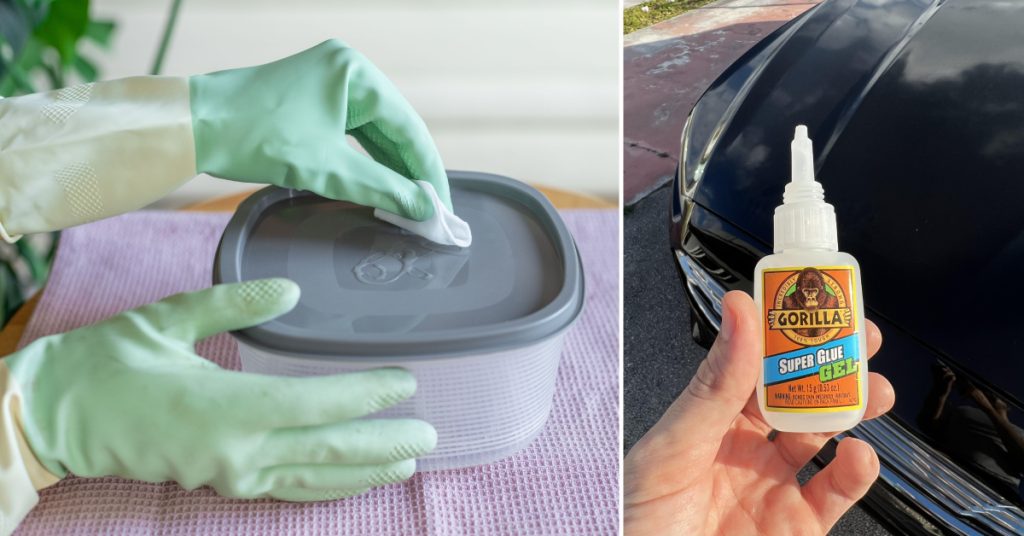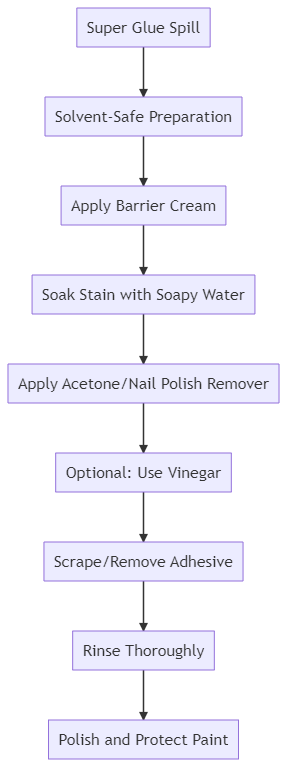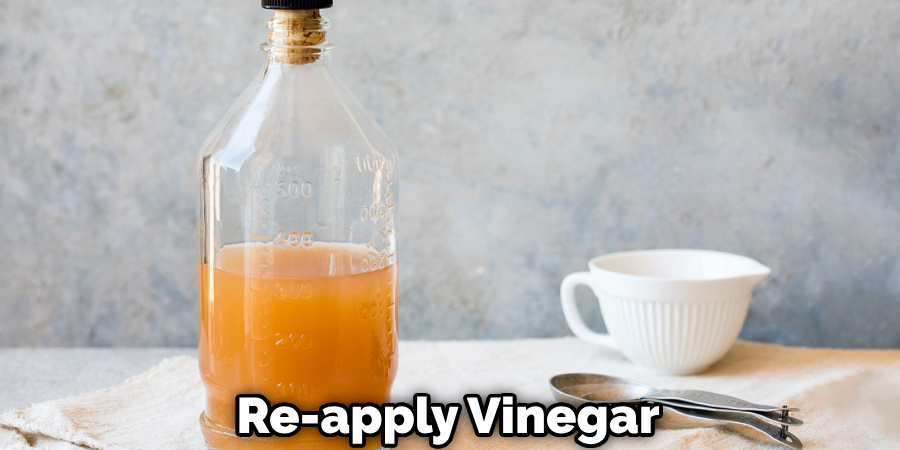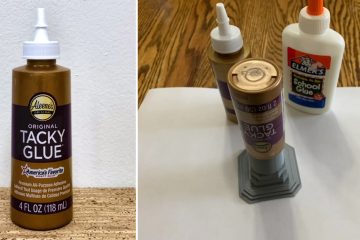We’ve all been there – that sinking feeling when a drop of super glue lands on your pristine car paint, furniture finish, or wall. It instantly bonds and you’re left puzzling over how to remove the super glue without causing further damage. Fret not! This guide how to get super glue off paint unleashes the secrets to effortlessly eradicating even the most stubborn glue stains.

Key Takeaways:
- Understand super glue’s chemistry to tackle removal effectively.
- Gather the right materials: acetone, vinegar, soap, razor blades, and protective gear.
- Follow the step-by-step process, working gently and patiently for the best results.
- Restore and protect the surface once the glue is removed.
Super Glue 101: Alchemy You Didn’t Sign Up For
We must first understand this modern adhesive alchemy to grasp the nuances of removing superglue from paint. Super glues, or cyanoacrylates, cure through an exothermic reaction with moisture in the air, rapidly polymerizing into an extremely strong plastic-like bond.
This inseparable union with the surface spells trouble for painted finishes. Attempting to simply scrape off cured superglue risks severe paint scratches and gouges. Using harsh paint strippers or solvents can also wreak havoc, discoloring or etching clear coats and lacquers.
Preparing for the Artistic Battle
Don’t be intimidated – with the proper materials and tactics, you can deftly remove super glue without a scratch. Gather these supplies:
- Acetone or nail polish remover containing acetone
- White vinegar
- Liquid hand soap
- Hand cream or petroleum jelly
- Clean cloths or paper towels
- Plastic razor blades
- Gloves
- Water
- Buffing compounds and waxes
Choose a well-ventilated work area and protect any surrounding paint with a barrier cream like petroleum jelly. Gloves are a must to safeguard your skin from solvents.

4 Authorative Steps for How to Get Super Glue Off Paint
Now we embark on the transformative journey of liberating your paint. Follow these steps meticulously:

Step 1: Re-moisturize the Adhesive
The first stroke towards victory is re-introducing moisture to that stubbornly dry superglue blob. Soak a cloth in warm water mixed with a few drops of liquid dish soap. Thoroughly wet the affected area and let it soak for 5-10 minutes. This revives and loosens the adhesive’s bond.
You can also try soaking with plain white vinegar – its acidity aids in breaking down the glue polymer.
Step 2: Apply Solvents Strategically
Next, we enlist acetone’s help, but with finesse. Dampen a fresh cloth with nail polish remover or pure acetone, and gently dab at the glue stain. Don’t soak or rub vigorously – this could drive solvents under the clearcoat.
Re-dampen the cloth as needed until you see the adhesive softening. Then use a plastic razor at a low angle to gently scrape and roll off the loosened super glue from the paint.
Step 3: Persist with Elbow Grease
For stubborn remnants, re-apply vinegar and let it dwell briefly before scraping again. You can make a baking soda solution to help dissolve any last traces.

The key is working patiently in sections, reapplying solvent sparingly, and scraping with care until that glue surrenders to your steady strokes.
Step 4: Revive and Protect
Once victorious, rinse the area thoroughly with clean water to flush away any solvent or glue residues. Restore that glossy brand-new look by polishing with a clearcoat-safe compound, following up with a quality wax or sealant.
Special Scenarios
Dealing with super glue on textured or porous surfaces? You may need to get a bit more hands-on with scrubbing brushes and extra soaking time.
Work in small sections following the steps above for large spills or dribbles. Trying to dissolve it all at once increases solvent risks.
If you run into any trouble areas, remember – the mantra is “least invasive first.” Start gently with just water and soap. Only escalate to harsher solvents if needed for that last sticky enigma.
Words to Stain By
You can outmaneuver even the most pernicious superglue spill on your car’s paint or any other surface with patience and care. No need for panic or expensive repair jobs!
- Work in sections when dealing with large areas to minimize solvent dwell time on paint.
- Test solvents first on an inconspicuous area to check for adverse reactions.
- Have a spray bottle with water handy to immediately rinse any area you suspect may have been overexposed to solvents.
- More aggressive solvents like lacquer thinner should only be used as an absolute last resort on clearcoat paints.

FAQs About How to Get Super Glue Off Paint
Can Dried Super Glue Be Removed?
Yes, dried super glue can be removed using acetone-based nail polish remover, which you apply to a cloth and gently rub on the glue. Alternatively, soaking the area in warm soapy water or applying white vinegar can help soften the glue for easier removal. For stubborn spots, a pumice stone or emery board can be used to gently file away the glue. Commercial glue removers are also available; just follow their instructions carefully. Always test any method on a small area first to avoid damage and ensure proper ventilation and skin protection when using chemicals.
What Removes Super Glue Fast?
To quickly remove super glue, use acetone (found in pure form or nail polish remover) to dissolve the adhesive by soaking a cotton ball and pressing it against the glue. For sensitive areas like skin, warm soapy water can help loosen the glue. On hard surfaces, combine acetone with a scraping tool for more effective removal. Additionally, a mixture of coconut oil and baking soda can serve as a mild abrasive to break down the glue.
What Removes Glue Without Removing Paint?
To remove the glue without damaging paint, you can use products like 3M General Adhesive Remover or common household items such as acetone (test first on a small area), white vinegar, rubbing alcohol, or warm soapy water. Simply apply the chosen solution to the glue, let it sit briefly to soften the adhesive, and gently wipe it away.
Conclusion
Arm yourself with the right materials and techniques from this guide. Proceed gradually, rinsing completely, and you’ll unveil a perfectly restored finish glistening with satisfaction.
The road to a blemish-free vehicle or home is now yours to navigate. Simply grab your tools, breathe deeply, and let your masterful hands do the brushwork!


